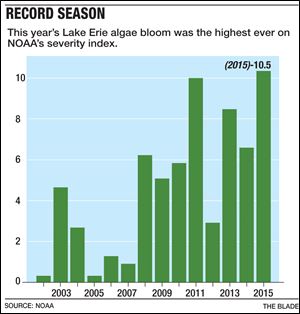
2015 was worst year yet for algae on Lake Erie
Agency says bloom large, not too toxic
11/11/2015
A U.S. agency noted that from late July through August a dense scum was detected covering more than 300 square miles of western Lake Erie. Still, no area water advisory was issued.
NOAA

A U.S. agency noted that from late July through August a dense scum was detected covering more than 300 square miles of western Lake Erie. Still, no area water advisory was issued.
The harmful algae bloom that spread a carpet of “dense scum” — the scientific term — over 300 square miles of western Lake Erie this summer was the largest since scientists started measuring the blooms in 2002, a federal agency announced Tuesday.
The National Oceanic and Atmospheric Administration rated the “severity index” level for this year’s harmful algal bloom at 10.5. That compared with a 10 in 2011, the previous highest year, NOAA’s bulletin said. The index is based on the total biomass in the algae bloom.
Toledo was spared a repeat of the do-not-drink advisory that occurred in 2014 because the toxicity of this year’s bloom was lower and the blooms were concentrated more in the center of the lake’s western basin, rather than the coastal areas, according to NOAA and scientists familiar with the issue.
April 2: Gov. Kasich signs bill to cut algae-feeding pollution.
May 6: EPA issues microcystin guidelines, suggesting limits of 0.3 parts per billion for young children and 1.6 ppb for adults. 2014’s do-not-drink advisory was tied to a 1.0 ppb threshold.
June 17: Early toxic algae spotted near Toledo.
June 23: Toledo’s water quality dashboard launches.
July 9: NOAA forecasts severe algae bloom season.
July 27: Microcystin found in raw lake water near Toledo intake.
Aug. 12: Water near intake tests at season high of 4.95 ppb. Drinking water still safe.
Oct. 8: Toledo’s water dashboard returns to “clear” for first time since July.
“The toxin concentration was relatively low for the biomass,” said Justin Chaffin, research coordinator for Ohio State University’s Stone Laboratory at Put-in-Bay.
He said water-plant operators are getting better at fending off the impact of the algal blooms because of new buoys and sensors installed this year.
“The bloom just wasn’t producing a lot of toxin, and the water-treatment plant operators had a better idea of what’s coming into their plant,” Mr. Chaffin said.
The algal blooms of 2014 overwhelmed Toledo’s water intake, causing a do-not-drink advisory that lasted nearly three days.
NOAA had predicted an intense, harmful algal bloom in the lake this year because of high rainfall that would lead to heavy discharge from the Maumee River, a major source of nutrients from fertilizer and manure on farm fields and livestock operations. But the amount of harmful algal bloom biomass was greater than it predicted.
“Over a 40-day period from late July to the end of August, the biomass detected from satellite exceeded that of any other time period we have monitored, except for the first week of October, 2011,” NOAA said. “On Aug. 5, dense scum covered up to 300 square miles of the western basin.”
Researchers do not yet understand why the level of toxins was so much lower, Mr. Chaffin said. The bulletin said the two major cold fronts in September weakened the bloom and caused it to decline much faster than in other major blooms.

A growing chorus is asking state and local officials to endorse having the U.S. Environmental Protection Agency designate the western basin as “impaired.” Such a designation would force polluters to be identified.
The Lucas County commissioners issued a jointly signed letter Oct. 15 that endorsed the designation.
They said there could be “negative perceptions” created by such a designation, but it is an important first step in restoring the health of the lake.
Former Toledo Councilman Mike Ferner based much of his recent unsuccessful mayoral campaign on his call for the impairment designation. He said it would require farms and livestock operations in Ohio, Indiana, and Michigan in the watershed to detail the manure and fertilizer that are applied to their property and to pay for the higher treatment costs imposed on Toledo.
A spokesman for Toledo Mayor Paula Hicks-Hudson refused to comment on whether she supports an “impairment” designation for the city.
Spokesman Janet Schroeder said the mayor was focused on the upcoming deadline to produce a balanced budget for 2016, and she is studying the issue before deciding whether to support a designation. She said a “cost-benefit” analysis is one consideration, but she would not elaborate.
Mr. Ferner said he’s written the mayor three letters urging the impairment designation.
“The U.S. EPA is the party that has the ability under the law to take care of it,” Mr. Ferner said.
Ed Moore, city director of Public Utilities, said the microcystin toxin generated by the harmful algal blooms were not a big problem this year compared with 2014, for the reasons given by NOAA. He said the city’s biggest problem was “total organic carbon” churned up from the bottom of the Maumee River by the breakup of winter ice this year. That drove the treatment cost up by $2 million, Mr. Moore said.
He said Ohio’s Lake Erie Islands, — Kelleys, Middle Bass, and South Bass — were more affected by the bloom than Toledo.
“The total organic carbon ... was a more of a problem than the microcystin, in our opinion,” Mr. Moore said.
Contact Tom Troy: tomtroy@theblade.com or 419-724-6058 or on Twitter @TomFTroy.